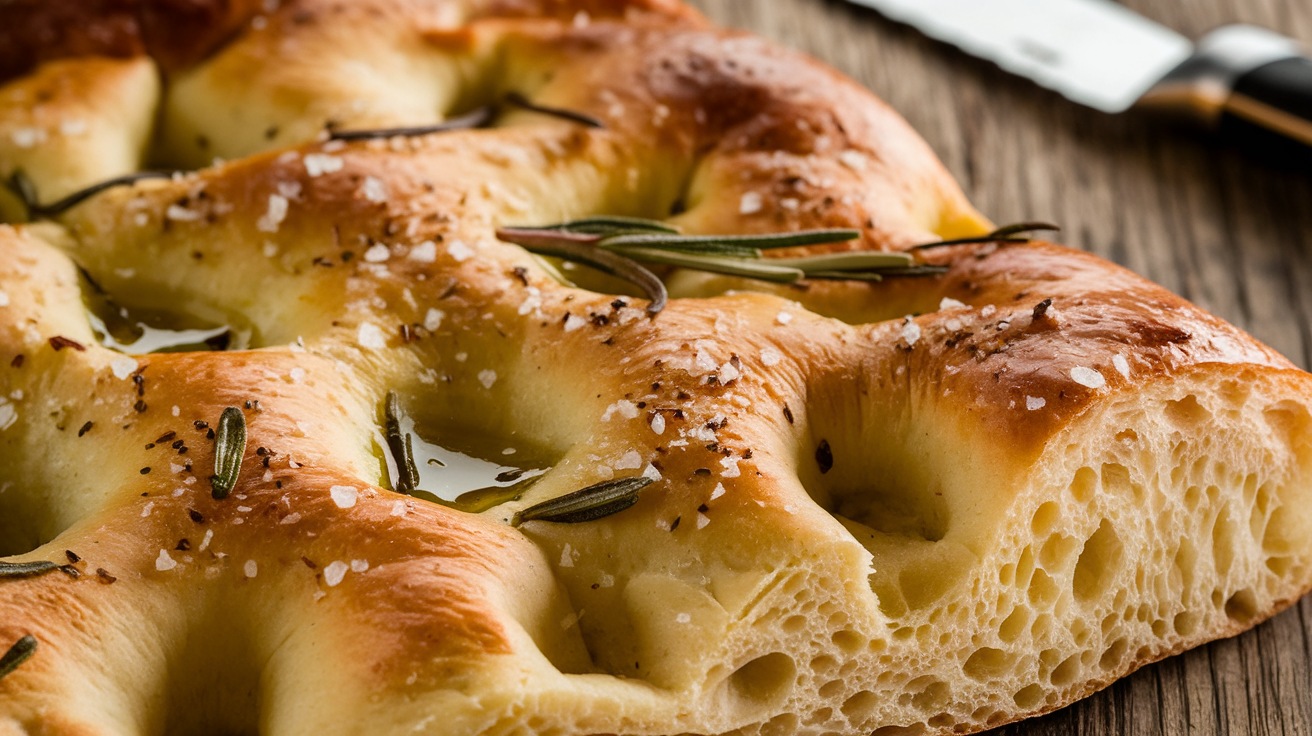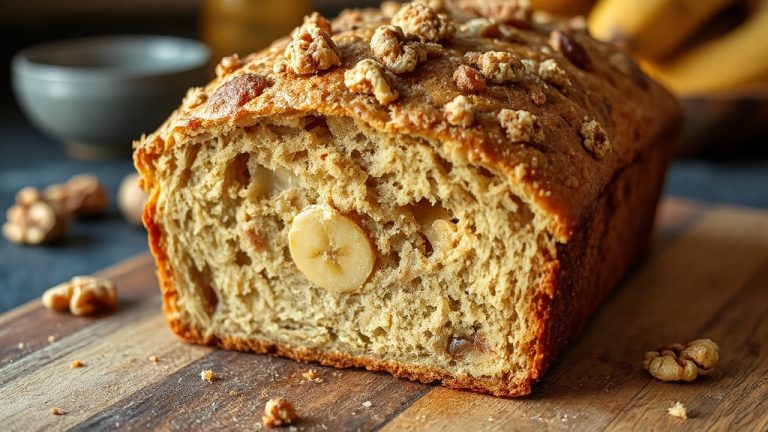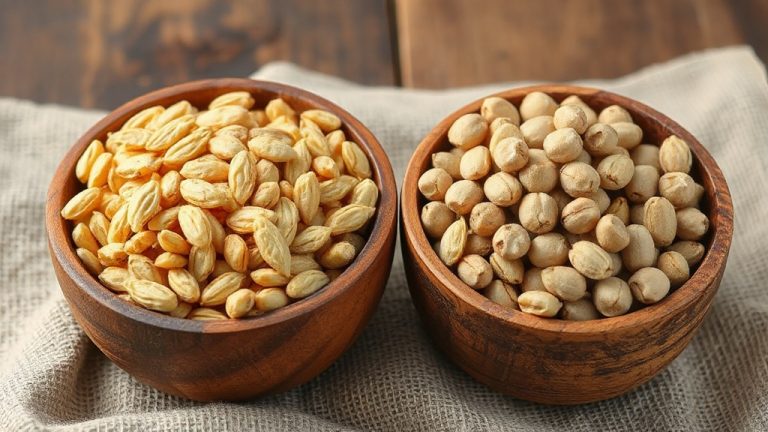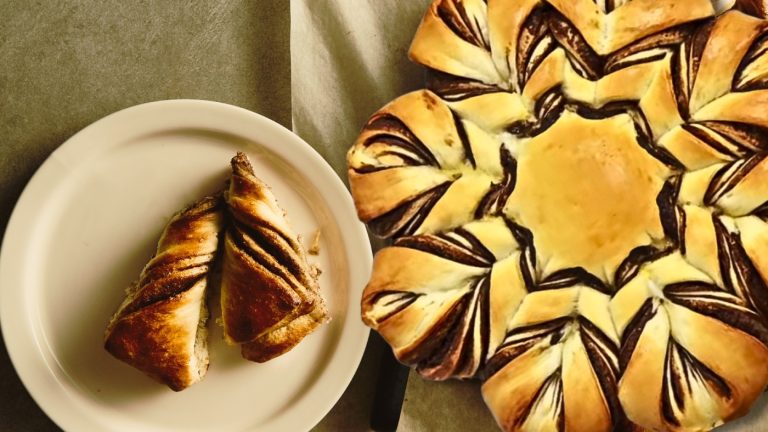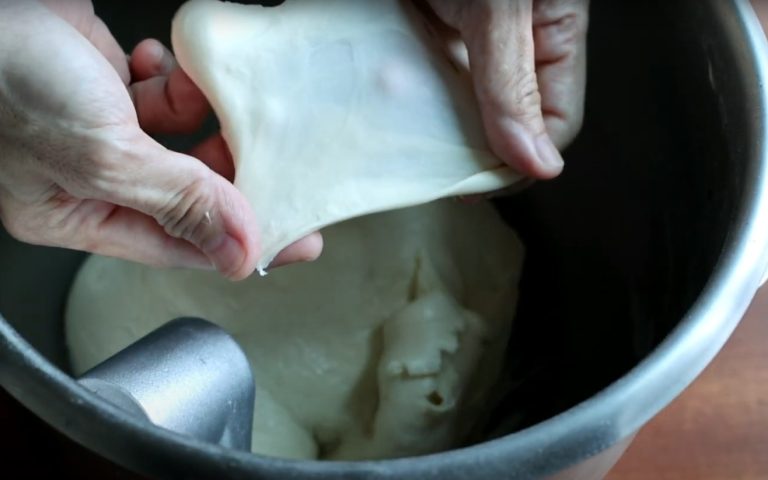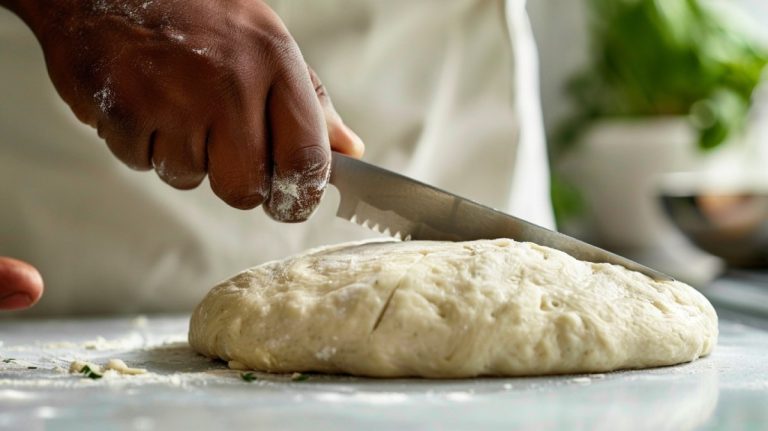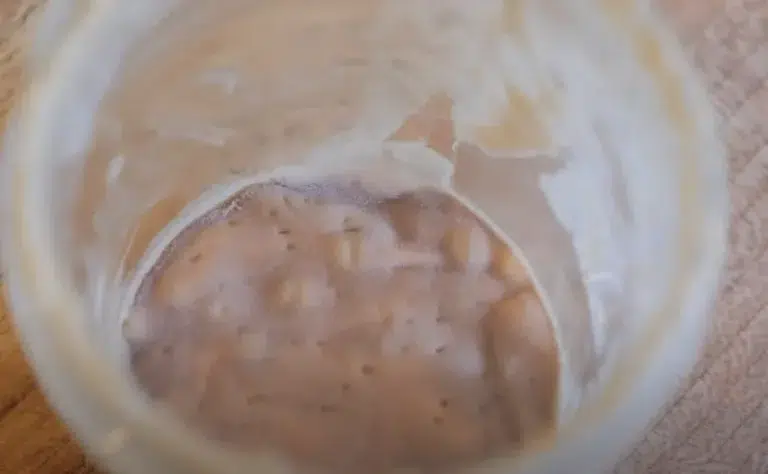Focaccia Genovese Recipe: With Fresh Herbs or As-Is
To make Focaccia Genovese, you’ll need high-quality flour, water, salt, and plenty of extra virgin olive oil. Start by activating 3.5 grams of yeast in warm water, then mix it with 390 grams of flour and salt until you form a shaggy dough.
Knead for 12 minutes until silky. Let it rise until doubled, then stretch it onto a greased pan.
Dimple the dough, drizzle with olive oil, and sprinkle sea salt before baking at 400°F for 25-30 minutes. This golden bread is perfect as-is or topped with herbs. Stick around to discover variations and storage tips.
Key Takeaways
- Use high-quality flour like 00 or bread flour with hydration levels above 80% for a light, airy texture.
- Activate 3.5 grams of yeast in warm water, then mix with flour, salt, and additional water to form a shaggy dough.
- Allow the dough to rise until doubled in size, then stretch to fit a greased baking sheet and proof for another hour.
- Dimple the dough before baking, drizzle with olive oil, and sprinkle with salt for enhanced flavor and texture.
- Bake at 200°C (400°F) for 25-30 minutes until golden brown and crusty, ensuring a crispy exterior.
Focaccia Genovese Overview
Focaccia Genovese, or fügassa as the locals call it, is a delightful Italian bread that hails from the picturesque city of Genoa. This Italian classic stands out with its crispy exterior and soft, tender interior, making it a beloved staple in many households.
Traditionally, you’ll find that baking this focaccia requires essential ingredients like flour, water, salt, and olive oil, often enhanced with a biga starter for that extra depth of flavor. Baking focaccia in a cast iron skillet can enhance the texture, providing a crispy crust and fluffy interior, which is essential for this recipe.
In Genoa, focaccia is typically around 2 cm thick, striking a perfect balance that’s both glossy and non-rubbery. The texture adds to its appeal, inviting you to take that first delicious bite.
You can customize your focaccia with a range of toppings like rosemary, olives, tomatoes, and onions, allowing for various regional adaptations that reflect the local palate.
As part of the Slow Food movement, focaccia Genovese is more than just a snack; it’s an experience to savor.
Essential Ingredients
To create a truly authentic Focaccia Genovese, you’ll need to gather some key ingredients that elevate this dish to new heights.
Start with high-quality flour, preferably 00 or bread flour, which provides the foundation for your dough. The hydration level is vital; for a light and airy texture, aim for a wet yet manageable consistency that’s typically above 80%, similar to a high hydration focaccia.
Then, add water—ideally, room temperature—to guarantee proper hydration.
Next, you’ll want to incorporate yeast, which brings life to your dough. A biga starter is highly recommended; it ferments slowly and adds depth to the flavor.
Add salt; it’s essential for balancing taste. Make sure to mix it evenly to avoid over-salting any specific area.
Flour Types Comparison
Choosing the right type of flour can make all the difference in achieving that perfect Focaccia Genovese. The flour you select influences the dough consistency, hydration levels, and, ultimately, the texture of your focaccia. Here’s a quick comparison of popular flour types:
| Flour Type | Texture & Characteristics | Best Use |
|---|---|---|
| 00 Flour | Soft, high protein; chewy consistency and airy crumb | Traditional Focaccia |
| Manitoba Flour | Strong, high gluten; enhances elasticity and strength | Thicker focaccia varieties |
| Bread Flour | Moderate protein (12-14%); slightly denser but good rise | Substituting for 00 flour |
| Whole Wheat Flour | Nutty flavor, higher absorption; may need hydration adjustments | Healthier, flavorful option |
Using 00 flour is a classic choice, giving your focaccia that deliciously chewy texture. If you’re looking for a heartier option, consider blending Manitoba flour for added strength. Bread flour is a viable substitute if you’re in a pinch, while whole wheat flour offers a unique twist. Adjusting hydration levels is essential when experimenting with different flours to maintain the perfect dough consistency.
Importance of Olive Oil
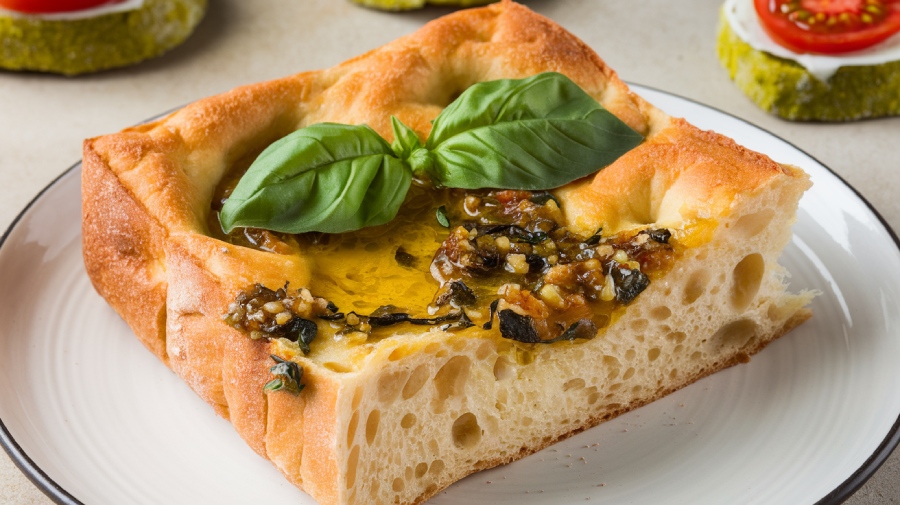
Olive oil plays a pivotal role in crafting the perfect Focaccia Genovese, elevating both its flavor and texture to new heights. When you use high-quality Extra Virgin Olive Oil, you’re not just adding a rich taste but also enhancing the bread’s overall richness. This oil is essential for achieving that irresistible crispy crust, which contrasts beautifully with the airy interior.
Incorporating seasonal ingredients along with olive oil can further enhance the dish’s flavor profile and visual appeal.
You’ll want to generously drizzle olive oil over the dough before baking, helping to create a golden, crunchy exterior. Additionally, the olive oil is vital in the brine poured into the dimples of the dough, infusing moisture and flavor throughout each bite.
The amount of olive oil you use greatly impacts the dough’s hydration. A hydration level of over 80% is recommended for a wet, manageable dough that results in that light, fluffy texture you crave.
Preparation Steps
Start your focaccia journey by activating 3.5 grams of active dry yeast in 60 mL of warm water (between 85°F and 95°F) for 3-5 minutes until it bubbles up.
Once your yeast is ready, combine it with 390 grams of bread flour, 300 mL of warm water, and 1/2 tablespoon of kosher salt to form a shaggy dough. Using high-protein bread flour enhances texture and chewiness, as seen in the proper kneading and rising techniques.
Knead and Rise: Achieving Silky, Airy Dough
Mix this dough using a stand mixer on low for 2 minutes, then increase to medium-high for 10 minutes until it’s elastic and smooth.
Next, allow the dough to rise in a warm place for at least 1 hour or until it doubles in size.
Once risen, stretch it to fit a greased 13×9.5 baking sheet and proof for another hour.
Now, here comes the fun part:
- Dimple the dough with your fingers, creating little pockets for the olive oil.
- Pour a generous amount of olive oil over the surface.
- Let it rise uncovered for 40-45 minutes.
Baking Techniques
Preheat your oven to 200°C (400°F). This temperature is essential for developing a crispy crust while keeping the inside soft and airy.
Before baking, make sure you’ve allowed the dough to rise adequately, ideally in a well-oiled bowl, to prevent sticking. Using parchment paper on your baking sheet will also make removal a breeze. If you’re using over-proofed sourdough, you can gently deflate it and let it rest for a bit before shaping, which will help improve the texture (transforming over-proofed dough).
Once your dough has risen, it’s time for the fun part: dimpling the dough. Use your fingers to create those signature dimples, which not only add texture but also help distribute toppings evenly.
For that extra crunch, incorporate steam baking techniques by placing a pan of water in the oven. The steam will enhance the crust’s crunchiness, making it crispy on the outside.
Sprinkle salt and olive oil over the surface before baking to infuse flavor. After 20-30 minutes in the oven, keep an eye out for a golden brown finish.
Common Variations
Focaccia Genovese is incredibly versatile, offering numerous ways to customize this beloved bread. The beauty of focaccia lies in its ability to adapt to your taste preferences and regional influences. You can experiment with various toppings and create your own unique variations.
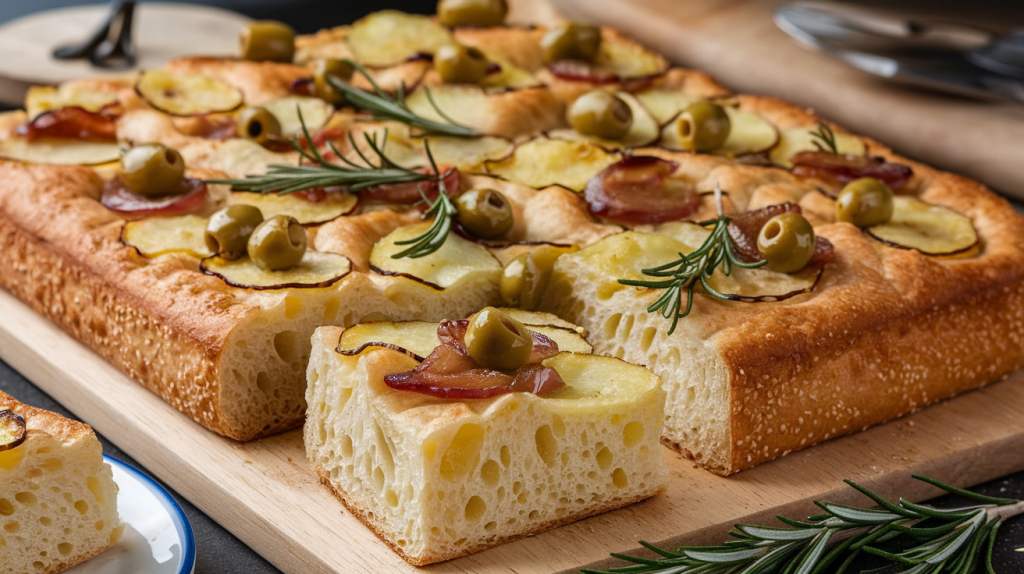
Here are three popular options:
- Herbed Delight: Top your focaccia with fresh rosemary, sage, or even dukkah for a fragrant and flavorful twist. A drizzle of high-quality olive oil and a sprinkle of sea salt will elevate it further.
- Cheesy Indulgence: For a richer version, consider adding mozzarella or taleggio cheese. The gooey texture melts beautifully, bringing a comforting element to the focaccia.
- Farinata: If you’re looking for a gluten-free alternative, try farinata, which is made from chickpea flour. This variation provides a distinct taste and is a great way to enjoy a different take on focaccia.
Regional differences also come into play, with some preferring a thicker, airier loaf while others lean towards a denser, flatter style.
Storage Tips
To keep your focaccia fresh and flavorful, you’ll want to store it properly.
For short-term storage, a paper bag at room temperature does wonders, while freezing it can extend its life for those moments when you crave a slice later on.
If you’ve got frozen focaccia, reheating it in the oven will bring back that delightful texture and taste you love.
Optimal Storage Conditions
When it comes to storing your delicious focaccia, following a few simple guidelines can make all the difference in maintaining its delightful freshness. To enjoy your focaccia at its ideal taste and texture, consider these storage tips:
- Room Temperature: For up to one day, store your baked focaccia in a paper bag at room temperature. This method helps retain its crispy texture while preventing it from becoming soggy.
- Cooling First: Always verify your focaccia is completely cooled before you store it. This step is essential to avoid condensation that could lead to a soggy crust.
- Freezing for Longevity: If you need to keep your focaccia for longer, freezing is your best bet. Just remember, only freeze baked focaccia, not raw dough.
When you’re ready to enjoy it again, pop it in a preheated oven to restore that delightful crispy texture—steer clear of the microwave, as it can make it soggy.
Freezing Techniques Explained
Freezing your focaccia can be a game-changer, allowing you to savor its delightful flavor long after baking. To make the most of your focaccia, wait until it cools completely before you start the freezing process. This step is essential; hot focaccia can create condensation, leading to sogginess.
Once cooled, slice your focaccia into portions for easier reheating later. Next, wrap each piece tightly in plastic wrap or aluminum foil. This protective layer helps prevent freezer burn, ensuring that the rich olive oil flavor and soft texture remain intact for up to three months.
Remember, while freezing baked focaccia works beautifully, you shouldn’t freeze raw focaccia dough. Doing so disrupts the yeast fermentation process, which is necessary for achieving that perfect rise.
When you’re ready to enjoy your frozen focaccia, simply take it out and reheat it in the oven at 350°F (175°C) for about 10-15 minutes. This will restore its crusty exterior, making each bite as delightful as the day you baked it.
Reheating for Best Flavor
Reheating focaccia Genovese correctly can transform your leftovers into a delightful treat, ensuring each bite retains that signature crispy texture and rich flavor. To achieve this, follow these simple steps:
- Preheat your oven: Set it to 375°F (190°C) to create the perfect environment for reheating. This temperature helps restore the focaccia’s crispy crust without drying it out.
- Add a drizzle of oil: Before you pop the focaccia in the oven, drizzle a bit of olive oil on top. This not only enhances the flavor but also adds moisture, ensuring your focaccia stays deliciously rich.
- Reheat with care: Place the focaccia directly on the oven rack or a baking sheet and let it reheat for about 10-15 minutes. Keep an eye on it—you’re looking for that perfect crispy texture and warmth throughout.
Avoid using the microwave, as it can make your focaccia soggy, ruining the delightful experience.
If you’ve frozen your leftovers, allow them to thaw in the refrigerator overnight before reheating for the best results.
Store any remaining focaccia in a paper bag at room temperature for one day or freeze longer portions in an airtight container.
Chef’s Recommendations
To elevate your Focaccia Genovese to restaurant-quality, pay close attention to the ingredients and techniques you choose. Start with high-quality extra virgin olive oil; use it both in your dough and drizzled on top before baking. This boost of flavor will also give your focaccia a glossy finish that’s irresistible.
Aim for a dough hydration level of over 80% to guarantee a light, airy texture. Don’t worry if it’s a bit sticky; that’s normal! Incorporating a biga starter is essential. Let it ferment for at least 12-14 hours to enhance the flavor profile and complexity of your focaccia.
Before adding brine and toppings, dimple the dough generously with your fingers. These characteristic pockets will help retain moisture and infuse flavor.
For the best crust, preheat your oven and bake at a high temperature of around 450°F (235°C). Keep a close eye on it to achieve that perfect golden brown finish without burning any toppings.
Follow these recommendations, and you’ll create a focaccia that rivals the best Italian bakeries!
Frequently Asked Questions
What Are the Two Types of Focaccia?
When you think of focaccia, two distinct types come to mind, each with its own allure.
First, there’s Focaccia Genovese, known for its soft, airy texture and crispy edges, tempting you with its simplicity.
Then, you encounter Focaccia alla Barese, thicker and adorned with vibrant toppings like tomatoes and olives.
Each type reflects its region’s unique charm, inviting you to savor the differences in flavor and texture.
Which one will you try first?
Which Flour Is Best for Focaccia?
When it comes to the best flour for focaccia, you’ll want to take into account 00 flour for its fine texture and gluten formation, giving your bread that airy quality.
Alternatively, bread flour, with its higher protein content, creates a chewy texture and sturdy structure.
You could also try a mix of Manitoba wheat and 00 flour for balanced results.
What Makes Focaccia Tough?
Making focaccia can feel like crafting a delicate work of art, but it can turn tough if you’re not careful.
Over-kneading the dough develops too much gluten, leading to a dense texture. If your dough’s too dry or you bake it at a high temperature for too long, you’ll end up with a hard crust and tough interior.
Also, using the wrong flour can really impact the final result, making it less tender.
Is Focaccia Dough Different Than Pizza Dough?
Yes, focaccia dough is different than pizza dough.
You’ll notice focaccia has a higher hydration level, making it softer and airier. It often incorporates more olive oil, contributing to its unique flavor and texture.
When you let it rise longer, it develops a rich taste that pizza dough doesn’t achieve.
Plus, focaccia bakes at higher temperatures for a crispier crust while keeping the inside tender, setting it apart from traditional pizza.
Experiment and Enjoy: Making Each Batch Uniquely Yours
Now that you’ve mastered the art of Focaccia Genovese, you’re well on your way to impressing family and friends with your culinary skills. Remember, “practice makes perfect.” Don’t hesitate to experiment with toppings or variations to make it your own.
Each batch is a chance to refine your technique and indulge in the delightful flavors of this Italian classic. So roll up your sleeves and enjoy the process—your taste buds will thank you.

